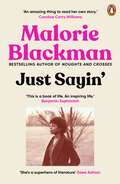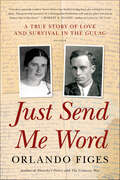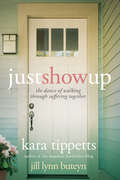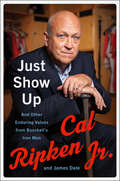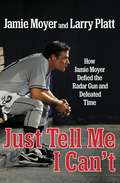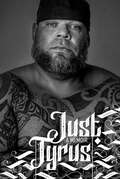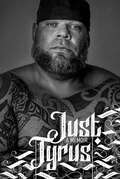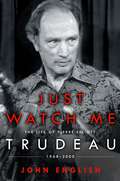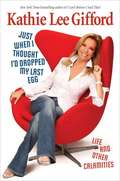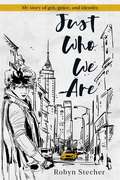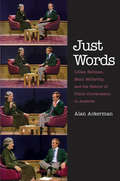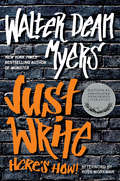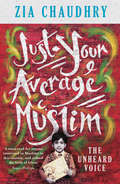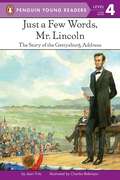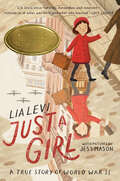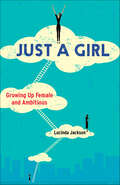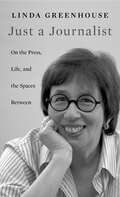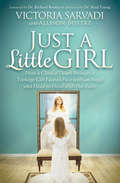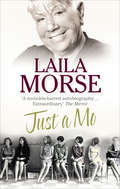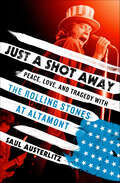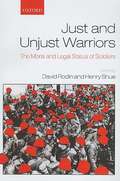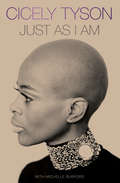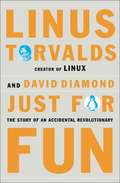- Table View
- List View
Just Sayin': My Life In Words
by Malorie BlackmanThe long-awaited autobiography of one of the world's greatest children's writers, and an empowering and inspiring account of a life in books.Malorie Blackman OBE is one of Britain's best loved and most widely-read writers. For over thirty years, her books have helped to shape British culture, and inspired generations of younger readers and writers. The Noughts and Crosses series, started in 2000, sparked a new and necessary conversation about race and identity in the UK, and are already undisputed classics of twenty-first-century children's literature.She is also a writer whose own life has been shaped by books, from her childhood in south London, the daughter of parents who moved to Britain from Barbados as part of the Windrush Generation, and who experienced a childhood that was both wonderful and marred by the everyday racism and bigotry of the era. She was told she could not apply to study her first love, literature, at university, in spite of her academic potential, but found a way to books and to a life in writing against a number of obstacles.This book is an account of that journey, from a childhood surrounded by words, to the 83 rejection letters she received in response to sending out her first project, to the children's laureateship. It explores the books who have made her who she is, and the background to some the most beloved and powerful children's stories of today. It is an illuminating, inspiring and empowering account of the power of words to change lives, and the extraordinary life story of one of the world's greatest writers.
Just Send Me Word: A True Story of Love and Survival in the Gulag
by Orlando FigesA heroic love story and an unprecedented inside view of one of Stalin's most notorious labor camps, based on a remarkable cache of letters smuggled in and out of the Gulag"I went to get the letters for our friends, and couldn't help but feel a little envious, I didn't expect anything for myself. And suddenly—there was my name, and, as if it was alive, your handwriting."In 1946, after five years as a prisoner—first as a Soviet POW in Nazi concentration camps, then as a deportee (falsely accused of treason) in the Arctic Gulag—twenty-nine-year-old Lev Mishchenko unexpectedly received a letter from Sveta, the sweetheart he had hardly dared hope was still alive. Amazingly, over the next eight years the lovers managed to exchange more than 1,500 messages, and even to smuggle Sveta herself into the camp for secret meetings. Their recently discovered correspondence is the only known real-time record of life in Stalin's Gulag, unmediated and uncensored. Orlando Figes, "the great storyteller of modern Russian historians" (Financial Times), draws on Lev and Sveta's letters as well as KGB archives and recent interviews to brilliantly reconstruct the broader world in which their story unfolded. With the powerful narrative drive of a novel, Just Send Me Word reveals a passion and endurance that triumphed over the tragic forces of history.
Just Show Up
by Kara Tippetts Jill Lynn ButeynKara Tippetts's story was not a story of disease, although she lost her battle with terminal cancer. It was not a story of saying goodbye, although she was intentional in her time with her husband and four children. Kara's story was one of seeing God in the hard and in the good. It was one of finding grace in the everyday. And it was one of knowing "God with us" through fierce and beautiful friendship. In Just Show Up, Kara and her close friend, Jill Lynn Buteyn, write about what friendship looks like in the midst of changing life seasons, loads of laundry, and even cancer. Whether you are eager to be present to someone going through a difficult time or simply want inspiration for pursuing friends in a new way, this eloquent and practical book explores the gift of silence, the art of receiving, and what it means to just show up.
Just Show Up: And Other Enduring Values from Baseball's Iron Man
by James Dale Cal Ripken Jr.New York Times Bestseller!Iron Man Cal Ripken Jr.—the 19-time All-Star, World-Series winning legend, American League MVP, and record holder who played 2,632 consecutive games—outlines eight rules for the game of baseball and life, drawn from the lessons he has learned on and off the field.Cal Ripken Jr. is a baseball legend. But legends aren't born, they're made. For twenty-one seasons, Ripken took the field day in and day out, through cold, heat, rain, and sometimes snow, playing in more than 3,000 games for the Baltimore Orioles. In 1983, the revered shortstop helped lead his team to victory in the World Series. On September 6, 1995, Ripken did the seemingly impossible, he surpassed Lou Gehrig's unbreakable fifty-six-year-old Iron Man record, setting a new mark of 2,131 consecutive games—then played another 501 consecutive games. Throughout his career, Ripken was admired for his consistency, hard work, and loyalty. There were successes and failures, but above all was an old-fashioned sense of doing what's right, every single day. Since retiring in 2001, Ripken has enjoyed a successful career as a baseball analyst, entrepreneur, and author. Now, in Just Show Up, he reflects on his life and career to offer lessons for the next generation and those to come. Ripken speaks eloquently about the timeless values he has lived by: Life is a streak,play the long game; Success and money are not the same; Play fair,win fair. And he shares stories of his legendary father, Baltimore Oriole coach and manager Cal Ripken Sr., what it took to keep the streak alive, and what it meant to bring the World Series to Baltimore.Cal Ripken's message is simple yet poignant; wisdom essential to anyone trying to forge a successful life in times that are often chaotic. Blending insights from sports, business, and a life well-lived, Just Show Up is the story of an American legend and the principles he has lived by—standards our time needs.
Just Tell Me I Can't: How Jamie Moyer Defied the Radar Gun and Defeated Time
by Larry Platt Jamie MoyerLong-time fans of the National Pastime have known Moyer's name for more than 25 years. That's because he's been pitching in the bigs for all those years. With his trademark three pitches - slow, slower, and slowest - the left-handed Moyer is a pinpoint specialist whose won-lost record actually got better as he got older -- from his 20s to his 30s and into 40s. He's only a few wins shy of 300 for his amazing career.But this is where the book takes an unusual turn. Moyer was just about finished as a big leaguer in his mid-20s until he fatefully encountered a gravel-voiced, highly confrontational sports psychologist named Harvey Dorfman. Listening to the "in-your-face" insights of Dorfman, Moyer began to re-invent himself and reconstruct his approach to his game. Moyer went on to become an All-Star and also a World Series champion.Yogi Berra once observed that "Half of this game is 90% mental." And Moyer's memoir proves it.
Just Tyrus: A Memoir
by TyrusPro wrestler and political commentator Tyrus goes deep into his wild but triumphant life story, from his painfully dysfunctional upbringing to bodyguarding for Snoop Dogg, to becoming a wrestling icon and one of the most provocative on-air voices today. &“I loved Just Tyrus. I read it in one day and cheered for him when I got to the end. Tyrus has written a book that is at once raw, tender, intelligent, candid, and hilarious. Tyrus took a very rough start to his life and used perseverance, confident humility, and accountability to land firmly on his feet. What a triumph!&” —Dana Perino, former White House Press Secretary to George W. Bush and Fox News anchor and hostThe product of a 1970s mixed marriage, George Murdoch learned to fight early in life, fending off both race-baiting bullies and the demons of a dysfunctional home. Couch surfing all through high school and most of college, the quick-witted, sharp-tongued giant played football, ran drugs, and bounced at clubs to try to survive. After a false start with the WWE, he eventually became Snoop Dogg&’s bodyguard and traveled the world with the hip hop legend, biding his time and honing his rap. When the WWE urged him to return, George became &“Brodus Clay&” and, for the next several years, reinvented himself numerous times under the watchful mentorship of the legendary Dusty Rhodes, &“the American Dream.&” He was eventually christened &“Tyrus,&” and shortly after, a chance social media encounter with Greg Gutfeld at Fox News resulted in Tyrus finding a new skill: sage social commentator. Ferociously funny, blunt, and tenacious, Just Tyrus traces his unlikely and spectacular rise. As always with Tyrus, it&’s in-your-face and offers no apologies. &“George aka Tyrus aka the realest most blunt human being on the face of planet earth. Never had a problem telling you what was on his mind or how he felt, good or bad. Tough exterior but a heart of gold. Front liner, great friend, and excellent coach for my youth football team. His work ethic is obvious, taking him from football to bodyguard to pro wrestler to a superb personality on Fox News. I&’ve seen him climb the ladder of success, and I&’m happy that I was along for the journey.&” —Snoop Dogg
Just Tyrus: A Memoir
by TyrusPro wrestler and political commentator Tyrus goes deep into his wild but triumphant life story, from his painfully dysfunctional upbringing to bodyguarding for Snoop Dogg, to becoming a wrestling icon and one of the most provocative on-air voices today. “I loved Just Tyrus. I read it in one day and cheered for him when I got to the end. Tyrus has written a book that is at once raw, tender, intelligent, candid, and hilarious. Tyrus took a very rough start to his life and used perseverance, confident humility, and accountability to land firmly on his feet. What a triumph!” —Dana Perino, former White House Press Secretary to George W. Bush and Fox News anchor and host The product of a 1970s mixed marriage, George Murdoch learned to fight early in life, fending off both race-baiting bullies and the demons of a dysfunctional home. Couch surfing all through high school and most of college, the quick-witted, sharp-tongued giant played football, ran drugs, and bounced at clubs to try to survive. After a false start with the WWE, he eventually became Snoop Dogg’s bodyguard and traveled the world with the hip hop legend, biding his time and honing his rap. When the WWE urged him to return, George became “Brodus Clay” and, for the next several years, reinvented himself numerous times under the watchful mentorship of the legendary Dusty Rhodes, “the American Dream.” He was eventually christened “Tyrus,” and shortly after, a chance social media encounter with Greg Gutfeld at Fox News resulted in Tyrus finding a new skill: sage social commentator. Ferociously funny, blunt, and tenacious, Just Tyrus traces his unlikely and spectacular rise. As always with Tyrus, it’s in-your-face and offers no apologies. “George aka Tyrus aka the realest most blunt human being on the face of planet earth. Never had a problem telling you what was on his mind or how he felt, good or bad. Tough exterior but a heart of gold. Front liner, great friend, and excellent coach for my youth football team. His work ethic is obvious, taking him from football to bodyguard to pro wrestler to a superb personality on Fox News. I’ve seen him climb the ladder of success, and I’m happy that I was along for the journey.” —Snoop Dogg
Just Watch Me: The Life of Pierre Elliott Trudeau, 1968-2000
by John EnglishThis magnificent second volume, written with exclusive access to Trudeau's private papers and letters, completes what the Globe and Mail called "the most illuminating Trudeau portrait yet written" -- sweeping us from sixties' Trudeaumania to his final days when he debated his faith.His life is one of Canada's most engrossing stories. John English reveals how for Trudeau style was as important as substance, and how the controversial public figure intertwined with the charismatic private man and committed father. He traces Trudeau's deep friendships (with women especially, many of them talented artists, like Barbra Streisand) and bitter enmities; his marriage and family tragedy. He illuminates his strengths and weaknesses -- from Trudeaumania to political disenchantment, from his electrifying response to the kidnappings during the October Crisis, to his all-important patriation of the Canadian Constitution, and his evolution to influential elder statesman.From the Hardcover edition.
Just When I Thought I'd Dropped My Last Egg: Life and Other Calamities
by Kathie Lee GiffordFrom Kathie Lee Gifford, beloved television host and bestselling author of "I Can't Believe I Said That," comes a funny, candid, and personal collection of essays This smart and witty collection of opinions, observations, and anecdotes covers a broad range of personal topics. Kathie Lee Gifford's stories are often funny, sometimes heartfelt, and always compelling--think Nora Ephron's" I Feel Bad About My Neck" meets Carol Burnett. No subject is off-limits: talking to her kids about sex, being married to Frank Gifford, embarrassing professional gaffes, run-ins with celebrities (of which there are many), the harsh and funny realities of aging. It's all here, told with intelligence, grace, and comedic wit. Written by Gifford's own hand, this highly original and readable volume will make you laugh out loud as you reach for the phone to share one of these charming, quirky, and colorful observations.
Just Who We Are: My Story of Grit, Grace, and Identity
by Robyn StecherRobyn Stecher explores the challenges of life in NYC, being a woman in a "man's world," and raising a child with special needs through marriage-divorce-remarriage. Told with the bluntness of voice of New York City and touched with the personal warmth of the author.
Just Words: Lillian Hellman, Mary Mccarthy, and the Failure of Public Conversation in America
by Alan AckermanIn an appearance on The Dick Cavett Show in 1980, the critic Mary McCarthy glibly remarked that every word author Lillian Hellman wrote was a lie, "including 'and' and 'the.'" Hellman immediately filed a libel suit, charging that McCarthy's comment was not a legitimate conversation on public issues but an attack on her reputation. This intriguing book offers a many-faceted examination of Hellman's infamous suit and explores what it tells us about tensions between privacy and self-expression, freedom and restraint in public language, and what can and cannot be said in public in America.
Just Write: Here's How!
by Walter Dean MyersAfter writing more than one hundred books, it still amazes me that I have been lucky enough to spend most of my life doing what I truly love: writing. What makes a writer? The desire to tell a story, a love of language, an eye for detail, practice, practice, practice. How well should you know your characters? Do you need to outline before you write? How important is length? Now Walter Dean Myers, the new National Ambassador for Young People's Literature and New York Times bestselling and award-winning author, walks you through the writing process. Includes: Examples from his writing and reading experiences Walter's six-box and four-box outlines for writing fiction and nonfiction Excerpted pages from Walter's own notebooks An afterword by Ross Workman, Walter's teen coauthor of kick Writing tips from both Walter and Ross Anyone can be a writer, with a little help from Walter Dean Myers!
Just Your Average Muslim
by Zia ChaudhryToo often we see Islam and Muslims portrayed as fanatical jihadists or helpless victims of western oppression. This book provides a rare insight into what, as the book"s title states, the average Muslim makes of it all.
Just Your Average Muslim
by Zia ChaudhryToo often we see Islam and Muslims portrayed as fanatical jihadists or helpless victims of western oppression. This book provides a rare insight into what, as the book"s title states, the average Muslim makes of it all.
Just a Few Words, Mr. Lincoln: The Story of the Gettysburg Address (Penguin Young Readers, Level 4)
by Jean FritzAbraham Lincoln was one busy man. He had a country to run. And a war to win. And a family to care for. But when it came time to honor all the soldiers who had died in the great battle of Gettysburg, President Lincoln still took time to say a few words. Two hundred and seventy-one to be exact. Here is a true story about a great man and his famous speech.
Just a Girl: A True Story of World War II
by Lia LeviIn this award-winning memoir translated from Italian to English, a Jewish girl grows up during a difficult time of racial discrimination and war, and discovers light in unexpected places. This classic, powerful story from Lia Levi is adapted for young readers, with beautiful black-and-white illustrations, a family photo album, and a powerful author’s note to readers. 1938, Italy. Six-year-old Lia loves to build sandcastles at the beach and her biggest problem is her shyness and quiet, birdlike voice—until prime minister Mussolini joins forces with Hitler in World War II, and everything changes.Now there are laws saying Jewish children can’t go to school, Jews can’t work, or go on vacation. It’s difficult for Lia to understand why this is happening to her family. When her father loses his job, they must give up their home and move from city to city.As war comes closer, it becomes too dangerous to stay together, and Lia and her sisters are sent to hide at a convent. Will she ever be “just a girl” again?The memoir is full of poignant moments of friendship and loss, dreaded tests at school, told in Lia's captivating voice, as she grows into a young teen. Just a Girl is an important addition to the WWII Jewish canon.
Just a Girl: Growing Up Female and Ambitious
by Lucinda JacksonJust A Girl is the sensitive, personal story of the author’s ambition to become and succeed as a scientist during the “white man in power” era of the 1950s to 2010s. In the male-dominated science world, she struggles from girlhood unworthiness to sexist battles in jobs on the farms and in the restaurants of America, in academia’s laboratories and field research communities, and in the executive corner office. Jackson overcomes pain, shame, and self-blame, learns to believe in herself when others don’t, and becomes a champion for others. The turbulent legal and social background of sexual harassment and sexism in America over seven decades is delivered as “history with emotion.” Just a Girl is also a call to action: it identifies the court cases and lawsuits that helped advance the cultural changes we see today; outlines the pressing need for a Boys and Men Liberation (BAML) movement; highlights new approaches by parents; advocates for changes in our universities; and suggests a different direction for corporate America to take to stop the cycle of sexual harassment. Eye-opening and inspiring, it points the way to a brighter future for women everywhere.
Just a Journalist: On the Press, Life, and the Spaces Between (The William E. Massey Sr. lectures in American studies ; #2015)
by Linda GreenhouseA Pulitzer Prize–winning reporter who covered the Supreme Court for The New York Times, Linda Greenhouse trains an autobiographical lens on a moment of transition in U.S. journalism. Calling herself “an accidental activist,” she raises urgent questions about the role of journalists as citizens and participants in the world around them.
Just a Little Girl: How a Clinical Death Brought a Teenage Girl Face-to-Face with an Angel and Head-to-Toe with Her Faith
by Allison Bottke Victoria SarvadiA teenager. A near-death experience. A spiritual journey that will last a lifetime. “Her testimony will ignite the flame of faith in many” (Susie Jennings, author of 31 Days of Mountaintop Miracles).When eighteen-year-old Victoria dies in the ICU and encounters an angel that gives her a prophetic mandate from God, her insatiable quest for spiritual enlightenment begins. As compelling as any contemporary novel, this dramatic and inspiring true story is a roller-coaster ride through supernatural experience, denominational enlightenment, and a teenage marriage that not only survives the loss of a child but thrives through unbeatable odds.Shining a fresh light on the theology of a Jewish Jesus, the author deftly weaves the history of the Christian faith from its genesis of the first century to the present-day Greco-Roman Christianity—all the while giving us an up close and personal glimpse of an extraordinary life.A devoted wife, mother of six, and grandmother of nineteen, Victoria refuses to succumb to age and limitations. Far from Just a Little Girl, Victoria Sarvadi’s unconventional journey from teenage motherhood to Hebraic scholar and teacher will captivate and consume you from start to finish.“Heartwarming, encouraging, inspirational and hard to put down. A very personal and uplifting book filled with life as it is. . . . A testament of God, His love, and faith in answered prayers.” —Dr. Chris and Sasha Holloway, ministers and recording artists“Dr. Victoria Sarvadi is a storyteller unlike none other and her story is so unique and special that it moved me to tears, laughter and mostly to give thanksgiving to our G-D. This book is a must read!” —Rabbi Itzhak Shapira, author of The Return of the Kosher Pig
Just a Mo: My Story
by Laila MorseThe reigning queen of Albert Square, Laila Morse shares her incredible story for the first time. This is a book that will shock, humble and inspire.
Just a Shot Away: Peace, Love, and Tragedy with the Rolling Stones at Altamont
by Saul Austerlitz“The most blisteringly impassioned music book of the season.” —New York Times Book ReviewA thrilling account of the Altamont Festival—and the dark side of the ‘60s.If Woodstock tied the ideals of the '60s together, Altamont unraveled them. In Just a Shot Away, writer and critic Saul Austerlitz tells the story of “Woodstock West,” where the Rolling Stones hoped to end their 1969 American tour triumphantly with the help of the Grateful Dead, the Jefferson Airplane, and 300,000 fans. Instead the concert featured a harrowing series of disasters, starting with the concert’s haphazard planning. The bad acid kicked in early. The Hells Angels, hired to handle security, began to prey on the concertgoers. And not long after the Rolling Stones went on, an 18-year-old African-American named Meredith Hunter was stabbed by the Angels in front of the stage.The show, and the Woodstock high, were over. Austerlitz shows how Hunter’s death came to symbolize the end of an era while the trial of his accused murderer epitomized the racial tensions that still underlie America. He also finds a silver lining in the concert in how Rolling Stone’s coverage of it helped create a new form of music journalism, while the making of the movie about Altamont, Gimme Shelter, birthed new forms of documentary. Using scores of new interviews with Paul Kantner, Jann Wenner, journalist John Burks, filmmaker Joan Churchill, and many members of the Rolling Stones' inner circle, as well as Meredith Hunter's family, Austerlitz shows that you can’t understand the ‘60s or rock and roll if you don’t come to grips with Altamont.
Just and Unjust Warriors: The Moral and Legal Status of Soldiers
by Henry Shue David RodinCan a soldier be held responsible for fighting in a war that is illegal or unjust? This is the question at the heart of a new debate that has the potential to profoundly change our understanding of the moral and legal status of warriors, wars, and indeed of moral agency itself. The debate pits a widely shared and legally entrenched principle of war-that combatants have equal rights and equal responsibilities irrespective of whether they are fi ghting in a war that is just or unjust-against a set of striking new arguments. These arguments challenge the idea that there is a separation between the rules governing the justice of going to war (the jus ad bellum) and the rules governing what combatants can do in war (the jus in bello). If ad bellum and in bello rules are connected in the way these new arguments suggest, then many aspects of just war theory and laws of war would have to be rethought and perhaps reformed. <P><P>This book contains eleven original and closely argued essays by leading figures in the ethics and laws of war and provides an authoritative treatment of this important new debate. The essays both challenge and defend many deeply held convictions: about the liability of soldiers for crimes of aggression, about the nature and justifiability of terrorism, about the relationship between law and morality, the relationship between soldiers and states, and the relationship between the ethics of war and the ethics of ordinary life. <P><P>This book is a project of the Oxford Leverhulme Programme on the Changing Character of War.
Just as I Am: A Memoir
by Cicely Tyson“In her long and extraordinary career, Cicely Tyson has not only succeeded as an actor, she has shaped the course of history.” –President Barack Obama, 2016 Presidential Medal of Freedom ceremony"Just As I Am is my truth. It is me, plain and unvarnished, with the glitter and garland set aside. In these pages, I am indeed Cicely, the actress who has been blessed to grace the stage and screen for six decades. Yet I am also the church girl who once rarely spoke a word. I am the teenager who sought solace in the verses of the old hymn for which this book is named. I am a daughter and mother, a sister, and a friend. I am an observer of human nature and the dreamer of audacious dreams. I am a woman who has hurt as immeasurably as I have loved, a child of God divinely guided by His hand. And here in my ninth decade, I am a woman who, at long last, has something meaningful to say.” –Cicely Tyson <P><P> <b>A New York Times Bestseller</b>
Just as I Thought
by Grace PaleyThis collection of articles, reports, and talks by National Book Award finalist Grace Paley represents approximately 30 years of political and literary activity--with a couple of occasional glances over her shoulder into disappearing family and children--and comes as close to an autobiography as anything we are likely to have from this quintessentially American writer.
Just for Fun: The Story of an Accidental Revolutionary
by Linus Torvalds David DiamondIn a narrative that zips along with the speed of e-mail, Torvalds gives a history of his renegade software while candidly revealing the quirky mind of a genius.
